#ainu cuisine
Explore tagged Tumblr posts
Text
Rera’s crusade against ichiraku is low-key so people go to her parent’s place more because her grandma’s food is the best food
#➤ ooc┊ ❛ exit; pursued by a bear ❜#her granny cooks Ainu cuisine mostly and it’s stuff she’s grown up with so she’s BIASED#Idk what she’s got against the angst swing though
7 notes
·
View notes
Text

#for the record my stance on the amagi hometown is that they are not ainu but#if youre not connected to civilization then you can only work with what you can forage hunt or farm#which ends up being the same shit as is used in traditional ainu cuisine#so its a good jumping off point#BUT THIS FIC ISNT ABOUT THAT SO IT DOESNT MATTER!!!
3 notes
·
View notes
Text
I was lucky enough to visit Hokkaido for a few days, so of course I had to go look at some Golden Kamuy related places!

1. Hokkaido Kaitaku village is a big outdoor museum that archives old historical buildings, many of which appear in GK. So many, in fact, that the museum handed me a map where they list the buildings that appear in the manga and it was most of them.

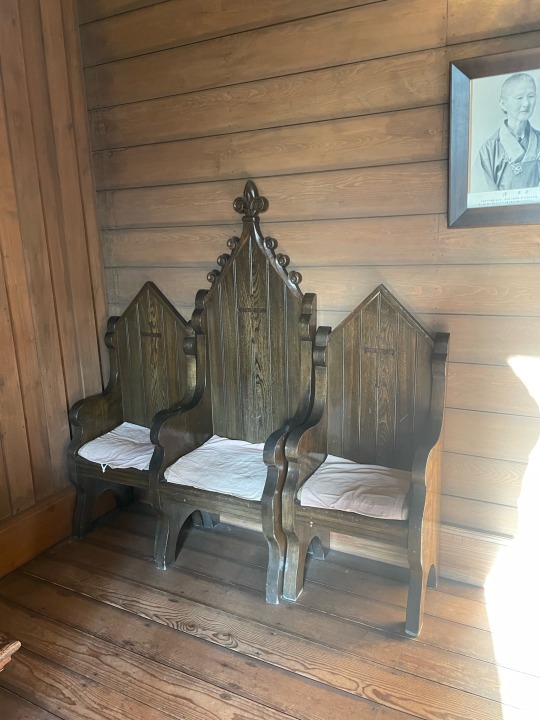
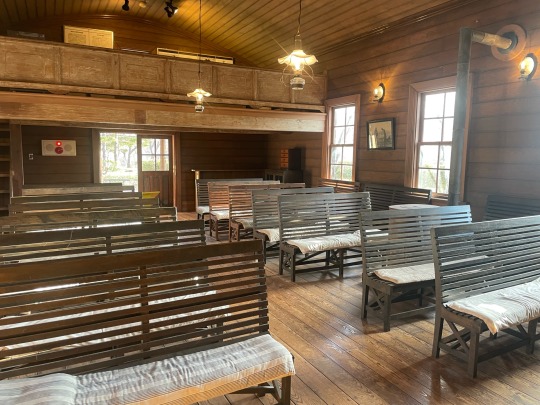
The church in which Tsurumi confronts Asirpa
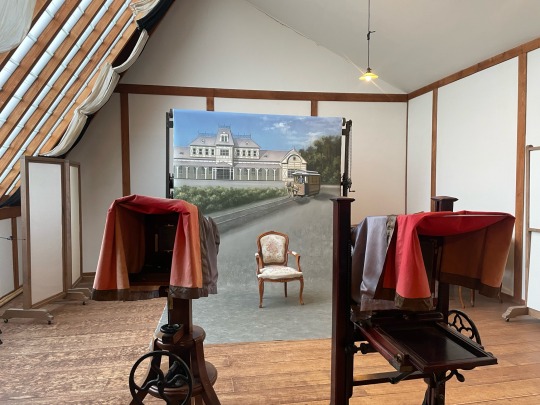

The photography studio
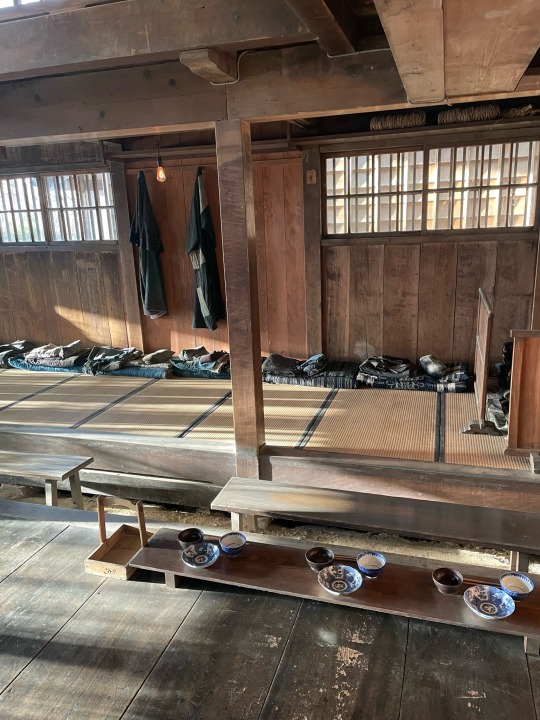
Herring fishermen's communal lodge


The infamous otter hotpot location👀
I even saw two cosplayers dressed up as Inkarmat and Suenaga doing a photoshoot together in an old clinic!
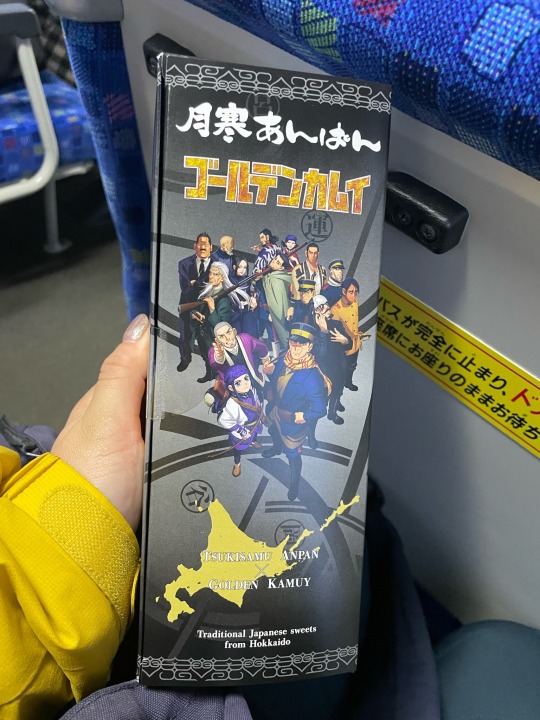

I couldn't not buy a box of GK Tsukisappu Anpan too.
2. The old Sapporo Beer factory
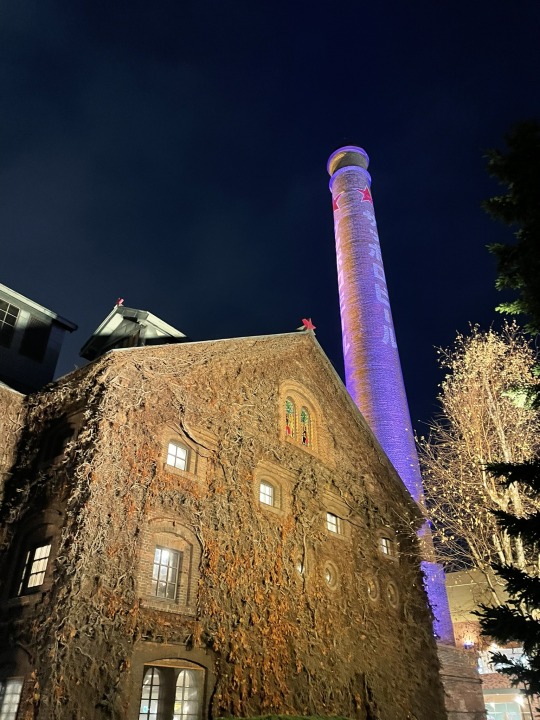
A lot went down here...
3. I went to an Ainu cuisine restaurant. I had a bear meat hotpot, deer meat skewers, tonoto (Ainu wine made from millet), ento herb tea, among other things. They were all amazing.




They had copies of GK volumes as well. I miss you Kiroranke.
4. I soaked up in an onsen at Noboribetsu.

The beautiful sulfuric Hell Valley at Noboribetsu.
Here I went to the Noboribetsu Bear Park and saw many Ezo Higuma bears. The males are so big, and while they are cute they would be utterly terrifying to encounter in the wild.

The park also had exhibits showing Ainu living spaces, tools, clothing, and explanations about the Iomante bear ritual which were really interesting.



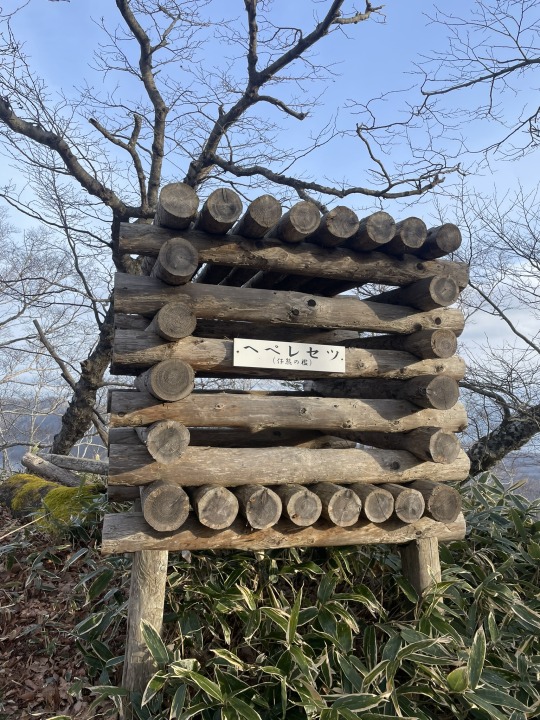
This was my first time in Hokkaido and it was an amazing experience. I only had a few days so I only saw Sapporo, Otaru, and Noboribetsu. I really wanted to see Abashiri prison but Hokkaido is a big island and I wasn't able to this time, but I aspire to go one day!
134 notes
·
View notes
Text
ive been thinking about this for a while, but i want to finally write my thoughts down about golden kamuy in reference to the meiji restoration because i think it’s so important to the central themes, especially that of cultural erasure.
with the end of the tokugawa shogunate came a surge in imperial nationalism, and the russo-japanese war did a lot to spur this on. social inequality in japan was ignored and accepted by many because of the belief that everyone should be happy to serve the emperor, and japan’s victory in the war was used as an argument for the validity of the new imperial rule as japan became able to challenge and compete with western powers. and that rise in japanese nationalism led to the desire to create a more cohesive national identity. one way that desire manifested was in the rebranding of ezo to hokkaido and the oppresion of the indigenous cultures that live there, namely the ainu.
now its not like golden kamuy is making an argument that the meiji restoration never should have happened, but it does call attention to one of the more controversial aspects of it that is often overlooked when people glorifiy of the meiji era as an ‘age of enlightenment’. it highlights that this nationalism crossed the line between unity and oppression. if ‘unity’ devolves into silencing voices and erasing tradition and culture in order to create a completely homogenous society, it ceases to be something worth having. sugimoto and asirpa’s friendship is proving that it is possible for cultures to coexist and share values without either one being erased. the focus on food in the show is very representative of this. asirpa introduces sugimoto to ainu cuisine, he introduces her to japanese cuisine, and although it takes some adjustment on both sides, they enjoy both, and sometimes combine elements of the two.
and that's why i think that no matter how outrageous the plot and characters are, it certainly succeeds as a piece of historical fiction.
#shut me up#golden kamuy#read an interesting book about meiji/taisho era sociology and shit this out
20 notes
·
View notes
Text
★ 𝐆𝐨𝐥𝐝𝐞𝐧 𝐊𝐚𝐦𝐮𝐲 𝐦𝐞𝐧 𝐚𝐧𝐝 𝐜𝐨𝐨𝐤𝐢𝐧𝐠 /𝟏 ★
★ 佐, 浩平, 洋平, 白石, Василий ★
★ 𝐖𝐚𝐫𝐧𝐢𝐧𝐠𝐬: /// ★
★ 佐 = 𝐒𝐚𝐢𝐜𝐡𝐢 𝐒𝐮𝐠𝐢𝐦𝐨𝐭𝐨, 浩平 = 𝐊𝐨𝐮𝐡𝐞𝐢 𝐍𝐢𝐤𝐚𝐢𝐝𝐨𝐮, 洋平 = 𝐘𝐨𝐮𝐡𝐞𝐢 𝐍𝐢𝐤𝐚𝐢𝐝𝐨𝐮, 白石 = 𝐒𝐡𝐢𝐫𝐚𝐢𝐬𝐡𝐢 𝐘𝐨𝐬𝐡𝐢𝐭𝐚𝐤𝐞, Василий = 𝐕𝐚𝐬𝐢𝐥𝐲 𝐏𝐚𝐯𝐥𝐢𝐜𝐡𝐞𝐧𝐤𝐨 ★
★ 𝐆𝐨𝐥𝐝𝐞𝐧 𝐊𝐚𝐦𝐮𝐲 𝐦𝐞𝐧 𝐚𝐧𝐝 𝐓𝐡𝐞𝐢𝐫 𝐜𝐨𝐧𝐧𝐞𝐜𝐭𝐢𝐨𝐧 𝐭𝐨 𝐟𝐨𝐨𝐝 𝐚𝐧𝐝 𝐜𝐨𝐨𝐤𝐢𝐧𝐠, 𝐞𝐚𝐭𝐢𝐧𝐠, 𝐭𝐚𝐬𝐭𝐞 𝐚𝐧𝐝 𝐬𝐤𝐢𝐥𝐥𝐬. 𝐓𝐡𝐞𝐢𝐫 𝐤𝐧𝐨𝐰𝐥𝐞𝐝𝐠𝐞 𝐨𝐟 𝐬𝐮𝐜𝐡 𝐭𝐨𝐩𝐢𝐜 𝐚𝐧𝐝 𝐭𝐡𝐢𝐧𝐠𝐬 𝐫𝐞𝐥𝐚𝐭𝐞𝐝 𝐭𝐨 𝐢𝐭. ★
★ 𝐖𝐨𝐫𝐝𝐬: 𝟔𝟏𝟒 ★
佐
“𝐈𝐓'𝐒 𝐍𝐎𝐓 𝐎𝐒𝐎𝐌𝐀𝐀𝐀𝐀𝐀𝐀” 佐 loves food and could be considered a foodie. Eating, tasting, cooking, using new ingredients, finding gourmet meals from around the World – Ainu, for example – is His. Each culture has something to it, that’s what He likes. He can cook very well. He might be a soldier, but His culinary skills are rich! He’s very culinary-oriented and all sorts of spices and stomach-pleasing dishes make something out of nothing. As people say, ‘Love goes through the stomach.’ and 佐’s Love definitely contains sharing food. Who would 佐 be, if He would not like Japanese food and specialities? And now, add Osoma.
浩平
“𝐅–𝐅𝐨𝐨𝐨𝐨𝐨𝐨𝐝?” 浩平 and His fate end up making Him behave differently. He eats, because He must. He is more picky than before His ‘accident’ too, but to make this balanced, He became more reserved for this army life. Therefore He does not waste food as some men among 7th Division would. Knowing at least the basics won’t help nowadays. 浩平 tends to view easily prepared dishes as hard and impossible. A moment where he does not pay attention and 佐 might appear. He cannot miss Him. He must not! Everything said does not mean that 浩平 does not like food. And to really note one speciality – a good Hokkaido ramen. Probably the only bearable thing about Hokkaido in His eyes. He loves it. He also likes mandarin oranges. He also loved buying His brother sweets, despite Him, not liking sweets much.
洋平
“𝐍𝐨𝐭 𝐛𝐚𝐝, 𝐚𝐜𝐭𝐮𝐚𝐥𝐥𝐲, 𝐈 𝐰𝐨𝐮𝐥𝐝 𝐬𝐚𝐲 𝐢𝐭'𝐬 𝐪𝐮𝐢𝐭𝐞 𝐚 𝐦𝐞𝐚𝐥.” 洋平 taste buds were always on the line of ‘too sour!’ and ‘too spicy!’. With sweets, He never had problems. He never really liked Them. And His older brother was always the one to spoil Him with Them. Trying His best in kitchen, 洋平 mastered few family recipes. But the mastery was always on 浩平 side. 浩平 did better with overall cooking and 洋平 with spices and salt. So naturally, the two of Them cooked together. Everything went faster and better with four hands occupying one or two pots. There were no dishes like a meal prepared with Mother’s love. And 洋平 was the first to cherish it before others.
白石
“𝐘𝐮𝐦𝐦𝐲 𝐘𝐮𝐦. 𝐓𝐡𝐢𝐬 𝐬𝐥𝐚𝐩𝐬 𝐡𝐢𝐧𝐧𝐚 𝐡𝐢𝐧𝐧𝐚.” 白石 rather eats than cooks. And plus points to those who pay for His food or become the chef. The best food comes from others and the only work behind it, for 白石, should be to eat it. Who saw any kind of king cooking? Not 白石. From north to south and Sun to Earth, 白石 can’t cook no food. Give Him a pot and water to boil, Your tent might burn to the ground. A rice? He eats it before it gets read. Meat? He ‘borrows’ it and… Well. It’s His meat now. Favourite food? Candy, and white rice. But, He can eat anything. Except deer brains. Not like They would go to waste next to His friends and companions.
Василий
"𝐔𝐡... семейный рецепт." Василий, coming from a poor family, never tasted many great meals. It never affected Him, each bite, smell or – if it was possible – hot meal! Those elements and details were like gifts to Him. Precious. Special. Most of the time unavailable. Василий can cook. That’s all that needs to be said. He's a handy man and loves cooking. Knowing that Russian cuisines are rich in ingredients and cultural background makes Him sometimes wonder… If there was no chance to really become an artist, what about the culinary field? Might help His mother too… With no specific preferences, Василий still has some favourites. Rice and pelmeni. But forbid if someone shows Him a dead squirrel!
#sugimoto saichi#nikaidou kouhei#nikaidou youhei#shiraishi yoshitake#vasily pavlichenko#golden kamuy#gk#gk sfw#food#cooking#headcanon
23 notes
·
View notes
Text
Y'know what's a weird thing that I want for Persona 6, that I think could be exciting to include given the possible theme of modernity vs tradition, or technology vs nature?
A character that's apart of the Ainu.
(***PLEASE NOTE, my knowledge of the Ainu people and their culture is fairly limited, so I will link down below some articles where you can learn more if you're interested!)
If you didn't know (because a surprisingly LARGE amount of people don't know about them), Japan has their own version of indigenous tribes, who have existed long before the establishment of modern Japan or even the monarchy.
One of these includes the indigenous peoples known as the Ainu, an ethnic group native to northern Japan, including Hokkaido, Northeast Honshu, as well as some territories and islands connected to Russia like the Kuril Islands, the Kamchatka Penisula, Sakhalin, and the Khabarovsk Krai.
While there is little history about their existence, we do know that the Ainu peoples are related to the Emishi, their ancestors, who during the 9th century came under Japanese subjugation and were pushed from their native lands to the north. Over the passing centuries, the Emishi and Ainu were treated with disrespect by both the early Japanese, who were known as Wa-jin, and later colonized by the more established dynasties that proceeded during the 17th century and beyond.
Today currently, there official population of the Ainu within Japan are around 25,000, but may actually be around 200,000 or more, due to the near-total assimilation into Japanese society, cutting off many individuals from knowing of their Ainu ancestry. Despite this though, the Ainu culture and their language somewhat prominent within their respective communities and continue to thrive, despite their dwindling numbers of the years.
In recent years, the culture has become a bit more well-known due to the fairly popular manga known as "Golden Kamuy", created by Satoru Noda and serialized from 2018 to 2022. The story is set after the Russo-Japanese war, where our main protagonist, Saichi Sugimoto, is a surviivng veteran of this war.
After learning about the possibility of a large cache of gold existing in Hokkaido, Sugimoto is nearly killed by the man who told him, but is saved from not only death by the man but also by a bear through the aid of a young Ainu girl named Asirpa. Together, the two of them form a very close friendship as they begin their complicated and dangerous journey to find the cache of gold, while collecting the tattooed map of the location of the cache.
The manga heavily focuses around the exploration of the Ainu culture, interweaving it with the plot of the manga, making it a very prominent and important topic within the story. Besides Asirpa, there are multiple Ainu characters that support the main cast, as well as many scenes exploring and discussing the culture of the Ainu and how the industrialization of Japan has affected their way of life.
One of my favorite scenes between Sugimoto and Asirpa is when she teaches him about some of their cuisine, in particular chitatap (or citatap), a dish made with the the raw meat of animals or fish that is chopped into fine chunks. Admittedly, Sugimoto is a bit worried about the idea of eating raw meat, but over the course of the story begins to fall in love with the dish to the point of obsessing over it.
Alongside that, there are also a few other representations too of the culture, such as the utilization of Ainu terms like "hinna" to express delight, the belief of "kamuy" or spirits in nature, or the tradition of Ainu women tattooing their lips! You can FEEL the authors love for the subject and wanting to let the wider world know about the existence of the Ainu, even though he might not be one himself.
So, why have an Ainu character? Well, for one, I think it would be a very interesting commentary upon some of the more complicated subjects that Japanese culture faces, and give a bit of representation to the tribe by having either a party member or supporting character within the town.
Persona is no stranger to dealing with complicated subjects and topics that are often shied away from in most JRPGS, notably SA, sexual harassment, depression, grief, struggling with ones own identity, sexuality, gender, and much more. The topic of the struggle of being indigenous not only in a judgmental and oppressive situation, but also a growing chokehold from the modern world as technology takes over, would be a very interesting thing to explore and provide one of many points of view upon the subject.
Its no question that many indigenous communities, including many in the United States, have been heavily affected by the growth of cities and the gentrification of areas, losing more and more of their territories everyday while backed into a corner. By writing about this, not only could the Persona team discuss the effects of the destruction of nature, but also the effects that it may have on smaller communities, be it indigenous tribes or merely small villages that exist outside the limits of cities!
So, whether or not this could happen, I think it'd be a really cool concept for Persona to explore and have, even if it might not take a center stage in the overall story!
Articles about the Ainu:
13 notes
·
View notes
Text
The Japanese word ジャガ芋 (potato) written also as ジャガイモ or じゃがいも comes from combining the word ジャガタラ, a corruption of Jakarta and 芋 used to describe most tuber vegetables. The connection comes from Dutch traders coming from Dutch East Indies being the ones to introduce potatoes to the Japanese. Used to be also written as ジャガタライモ, later shortened to the form used nowadays, probably due to the misspelling.
The Ainu word エモ (potato) comes from the Japanese いも. Potatoes in Ainu cuisine are listed as "imo" on the wikipedia page. Hokkaido was and still is the leading producer of potatoes in Japan, due to the it's colder climate, making it a good alternative to rice, which I also see as the way the Ainu were introduced to the crop.
The other Ainu word for potato - コソイミ - made me a bit sceptical. It was not listed in the dictionary, however I found it in some online resources listed as the primary word used. So I dug deeper. Turns out both words are correct, furthermore, イモ is also apparently accepted as an Ainu word. So, コソイミ comes from the Japanese 五升芋 written also as ごしょういも or ゴショイモ which is, I think, Jerusalem artichoke (assumption made based on these posts) more commonly known as 菊芋 or キクイモ.
5 notes
·
View notes
Text
I found the notes that I made when I visited Upopoy for the first time
Keep in mind, they were probably showing dialectal varieties. What I've written down might have been from dialects from all over the place, and thus people may know different words for the same thing.
ムックリ Mouth harps
tomtomkikir Firefly (meaning sparkle insect etymologically) (I believe this is of one specific dialect, but I did not write this down so I am uncertain)
pakno End
iran kor Start*
kinaorun Slug (dialectal)
ummakikir Water Strider (literally means horse insect)
topenni A (painted) maple (l.m. sweet tree)
sikina Real grass (l.m. real grass)
kakkok Cuckoo (l.m. crying bird)
pohko Bird
inau A ceremonial tool used in Ainu culture to offer gifts to the Kamuy. It is a medium for conveying prayers and messages from humans to the Kamuy. They are wooden sticks, with specific styles of carving depending on the message you would want to convey. The big important part of understanding inau is that it is a gift to the kamuy.
Shiretoko (probably to search later)
アイヌ語でチェペニパポといい、日本語では椀といい。
Ainu people would traditionally eat twice a day.
Look up: rataskep (important food to Ainu cuisine)
アㇷ゚ / カンキ The stick with a hook at the end that they would use to capture fish.
Makiri is the small knife, and it would be made from the antlers of deers.
Boys would become men at 15.
They used wooden pacifiers.
Babies would be given filthy names to ward off bad spirits until they were 2-3 years old, and their new and permanent name would be made based on their personality.
Noun+neg+verb
First person pronoun before the verb
Neg + I + verb
noun + neg + I + verb
cep terke = A fish splashes
aynu cep ma = A person roasts fish (lit. human fish roast)
No subject particles
aynu cep e A person eats fish
Even two nouns -> verb is at the end
ヤイトゥパレノオシャアヤン 안녕히 가세요
フプンノオカヤン 안녕히 계세요
イヤイライケレ Thank you (It used to be formal, but now is informal) The same goes to イランカラプㇷ゚テ as it used to be formal (e.g. when men wrote to someone*), but now it's equivalent to こんにちは。
スイ ウスカㇻアンロ See you later
Look up Shkushain War and Kunashir-Menashi Uprising.
*Unsure. 1) It might be 'inan kor'. 2) I definitely put "wrote" but I can't read the word I put after it.
#upopoy#I'm not confident on this one ngl#made these notes before I knew much#literally everything was the first time in these notes#ウポポイ#notes
1 note
·
View note
Text
"Traditional Ainu cuisine did not use steamed rice to make dumplings, as the Japanese did with mochi. The Ainu first came in contact with Japanese style mochi after the Edo period when more ethnic Japanese moved to live in the same areas as the Ainu under the land contract system."
Me: 🤫
#(Itsuki and her people might be heavily inspired by the Ainu but yeah she's not a 100% accurate portrayal of them)#(NOR did they actually say she is Ainu in-series)#(SO LET HER MAKE HER PRETTY MOCHI)#(BUT ALSO this is a fun little bit of Ainu trivia!)#(Also I don't know why I gotta bring this up like-- Masamune has bike handles on his horse while Ieyasu's retainer is a giant mecha)#(Chill girl everyone knows Basara is already silly)
0 notes
Text
Securing Your Japan Visa Online: Essential Guide and Top Reasons to Explore Japan

Hitting the Japanese road? It's important to know the japan online visa requirements whether you're going for a business meeting, to see the cherry blossoms, or to visit one of the country's historic temples. This complete guide will help you figure out what you need to make the application process go smoothly and the 5 main reasons you must visit Japan Five great reasons to visit Japan:
Cherry Blossoms: Japan is beautiful all year, but Cherry Blossom Season is especially lovely. Beautiful pink blossoms brighten the scene. Spring dinners beneath cherry blossom trees are popular in Japan.
Japanese Food: Sushi, ramen, and tempura are world-renowned Japanese dishes. In Japan, you can try the most authentic versions of these dishes while also discovering new ones.
Hokkaido: The northern island of Hokkaido features beautiful parks, hot springs, and wildlife. The Ainu people, who have their unique culture and cuisine, live there.
City Adventures: Japan's cities are filled with magnificent skyscrapers, delicious food, and exciting activities. Our journey will take us via Tokyo, Kochi, and Osaka, each with its unique charm.
Countryside Peace: Japan offers peaceful countryside to admire nature away from cities. The snow-covered Mount Fuji is a must-see. It is a breathtaking volcano and one of Japan's most famous landmarks.
Do I need a visa to go to Japan? To visit Japan, many tourists need to have a visa. What you need varies on where you are from, why you are visiting, and how long you plan to stay. Before you plan your trip, you should always check the most up-to-date Japan online visa rules. How to Get a Japan Visa: A Step-by-Step Guide No matter why you want to travel to Japan, applying for a visa online takes a few steps and a lot of paperwork. In general, all applicants need these things:
Form to Apply for a Japan Visa: First, fill it out online. Then print it out and sign it. Valid Passport: Make sure your passport has two blank pages and is good for at least six more months. Size of a passport Picture: Make sure you follow the exact measurements and background colour rules. Flight Itinerary: Show how you plan to get in and out of the airport without getting a ticket yet. Daily Itinerary: Write down what you plan to do each day in Japan. Proof that you have a place to stay: a hotel reservation or a letter from your host. Financial Records: Bank records or tax returns are proof that the business is solvent. Letter of Invitation: If you want to visit someone or go to a business meeting. Proof of Your Reason for Travelling: Documents that are specific to your type of ticket.
A certificate of eligibility (COE) from a sponsor in Japan is needed for visits that are not for tourism, work, or short stays. Instructions for the cover letter and photo A cover letter sent to the Embassy or Consulate tells them about yourself and your trip plans. Japan has rules about the size, background, and expression of the picture you need for your visa.
Documents that are unique to each travel purpose The papers you need can change depending on why you're going to Japan—for business, pleasure, school, work, vacation, or transit. Make sure you know what kind of visa you need by calling the Japanese Embassy or Consulate.
Invitation and Money Paperwork If you want to visit Japan for work or pleasure, you need an invitation letter from a host in Japan or a company. If someone is paying for your trip, you will need their promise letter and proof of funds. ID Card or Certificate of Eligibility For some kinds of visas, you need a COE, which your sponsor in Japan must get from the Immigration Services before you apply.
Remember that this guide isn't complete; you may be asked to provide more papers. Check to see if you need to send originals or copies of the papers. All papers should be written in English or Japanese. If they are not, you should have them translated by a professional.
Discover Japan with Ease: VisaCollect - Your Passport to a Stress-Free Visa Experience! Do you need help applying for a visa? Visit VisaCollect for help from professionals and make your dream trip to Japan come true. Remember that getting ready for the application process will make it go more smoothly. Have a great trip!
In conclusion To get your Japan online visa, you need to gather certain papers and carefully follow the application process. You must make sure you me Japan's visa requirements to have a smooth trip, whether you're visiting as a tourist, going to school, or looking to work.
FAQs How early should I get a visa for Japan?
Start the process three to six months before your trip if possible.
Can I get a visa for Japan online?
Yes, you can apply for some types of visas online. For more information, visit the webpage of the Japanese Embassy or Consulate.
What if I haven't bought my plane ticket yet?
You only need to make a trip plan when you apply; you don't have to buy the ticket.
Should I get a visa to visit Japan for a short time?
It depends on where you are from. Japan has deals with some countries that let them visit without a visa.
If I only have a tourist visa, can I work in Japan?
No, you need a certain type of work visa to work officially in Japan.
What is a COE (Certificate of Eligibility)? Do I need one?
For some kinds of visas, you need a COE, which a sponsor can only get in Japan . How long does it take to get a visa for Japan?
Times vary, but you should expect at least 5 working days for tourist visas. For other types of visas, it may take longer.
Can I get a longer visa while I'm in Japan?
Yes, but you need to apply before the end of your present visa.
What should I do if my visa application is turned down?
You can find out why you were turned down and maybe resume with more information.
Do kids need a visa to go to Japan?
Depending on the reason for their trip, all travellers, even kids, need the right IDs.
0 notes
Text
Fantastic find @mynnthia ! Thank you so much for sharing it and taking the time to write up your findings! As soon as I saw the illusion of Izutsumi's mom, I could tell that her clothing was from some North or Central Asian group, though I couldn't nail down which one, Mongolian and/or Siberian would have been my guess because I didn't know about this specific group. Definitely not Ainu though, it's lacking a lot of key Ainu style points. One of the great things about Dungeon Meshi being set in a different world from ours is that while we can often identify the cultural source of a costume, food or tradition, the countries and nationalities of our world don't exist in Dungeon Meshi... That gives us a lot of freedom to imagine the world any way we wish. There's so much to work with! It does get tricky to talk about though, since Ryoko Kui hasn't given us any country or culture names for her world. For example Kabru's name is Nepali, but there's no Nepal, his village has a Northern Asian name (Utaya is in Siberia IRL) but there's no Siberia either. Marcille's name is Italian and they imply that Italian food is her regional cuisine, but there's no Italy. Laios and Falin seem to come from a Scandinavian region, the elves seem like a cross between neoclassical Europe and the Roman Empire, etc. etc. But the cultural references are clearly there and she obviously spends a lot of time working these things out, and I love seeing people talking about all of these details!
If you find anything else cool like this please share it with the fandom! I know I'll be following you in case you do.
hypothesis on the ethnic/cultural background of izutsumi's mom
[disclaimer: i am not a professional ethnographer, nor of any of the ethnic groups mentioned in the post. this post was written based on research done over the course of a day.
if you have any corrections, feedback, etc, please feel free to inform me! my inbox/dms are open. if there is any misinformation present, i aim to correct them] ----------
idk if anyone else into dungeon meshi has noticed this, but i think izutsumi's mom (and therefore, izutsumi herself) might've been of Nivkh (indigenous east Siberian) heritage?
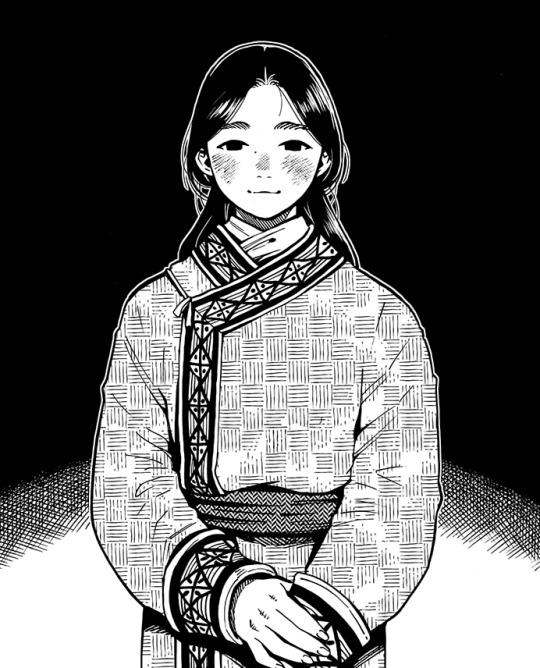
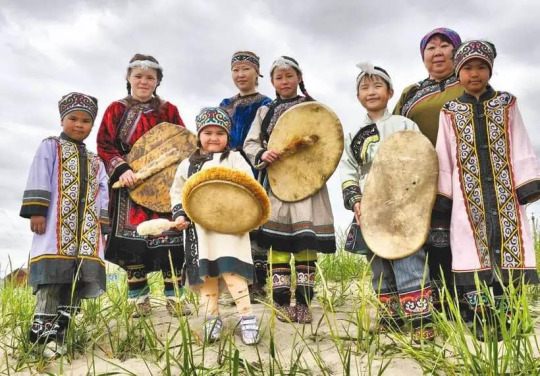
[details and explanation under the readmore, its slightly long]
when dungeon meshi chapter 59 came out (~2019), i saw a few people speculating that izutsumi's mom might've been Ainu because of how her clothing style notably differed from typical Japanese clothing.
while the Nivkh robe's trim features a different pattern style (swirly) than what izutsumi's mom wears (triangular), the Nivkh robe still looks to be a closer match than Ainu robes, especially in the collar/neckline & sleeve cuff areas.
note how the Ainu robes (image 2) have a different neckline style and wider sleeves:


heres more images of the robes, but from the past this time, found in Wikimedia Commons:
image 1: Nivkh robe from 1871 image 2: Sakhalin Ainu girl (left), Nivkh boy (center), Hokkaido Ainu girl (right) in 1912


Nivkh people have had interactions with Japan dating back centuries too. heres an exerpt from wikipedia:
"For many centuries, the Nivkh were tributaries of the Manchus. After the Treaty of Nerchinsk in 1689, they functioned as intermediaries between the Russians, Manchu and Japanese, and also the Ainu, who were vassals of the Japanese. Early contact with the southern Sakhalin Ainu was generally hostile, although trade between the two was apparent"
(sorry historians for quoting wikipedia as a source here. a lot of the more reputable sources are 20-200+ page papers, and not concise enough to put on a tumblr post)
the English language wiki doesnt have much more detail on Nivkh-Japan relations unfortunately, but there seems to be more info on the Japanese language version of the page.
i've also seen at least 1 speculation that izutsumi's mom might be Mongolian, as her robe somewhat resembles a Mongolian deel. in my opinion, the robe's neckline trim having patterning makes it resemble the Nivkh robes more. this – combined with the fact that prior to the 1900s, Japan-Mongolia relations consisted mostly of Mongolian forces trying to invade japan repeatedly – makes me think Nivkh (or some other indigenous east Siberian) heritage is more likely.
i wont rule it out entirely though, as i don't know how much Ryōko Kui cares about historical-based cultural relations. regardless, here are various deel styles across different Mongolian ethnic groups, if that is of interest to anyone:
i dont really have a profound conclusion for this post tbh. i wanted to document what i found, and figured i might as well share it to tumblr.
theres limited amounts of easily accessible information on traditional eastern Siberian clothing out there, but here's 1 source i found that goes over a few groups (including Nivkh):
344 notes
·
View notes
Text
Luxury Travel for Photographers - A Journey Through Hokkaido
Capturing Hokkaido's Breathtaking Landscapes: A Photographer's Dream Hokkaido, the northernmost island of Japan, is a dream destination for photographers. With its breathtaking landscapes, varied topography, rich culture, and welcoming people, Hokkaido offers a unique blend of adventure and luxury. Whether you're a professional photographer or a hobbyist, Hokkaido has something for everyone. The Charm of Hokkaido's Landscapes Hokkaido's stunning landscapes include mountains, forests, lakes, rivers, and coastline, offering endless opportunities for photographers. The vast terrain is especially captivating during the autumn season when the leaves turn into a fiery blaze of colors. The spellbinding vistas of lavender fields in Furano and Biei, or the snow-covered rural landscape in the winter months are other breathtaking landscape opportunities. The Culture of Hokkaido Hokkaido has a rich indigenous culture, and its unique festivals and traditions offer vibrant and colorful photography opportunities. The Ainu communities, the indigenous people of Hokkaido, have a distinct culture that visitors can experience through their cuisine, crafts, and folk music. The Sapporo Snow Festival, held every February in Hokkaido's capital, is another vibrant cultural event that attracts visitors from all over the world for its stunning snow sculptures. Wildlife Photography Opportunities Hokkaido is also known for its wildlife photography opportunities, with brown bears, red-crowned cranes, and Steller's sea eagles among the highlights. The Akan International Crane Center in Kushiro and the Shiretoko National Park are among the best places to capture the beauty of Hokkaido's wildlife. Photographic Tours and Workshops To get the most out of your photography trip to Hokkaido, consider joining a guided photographic tour or workshop. Professional photographers and local guides offer expertise and assistance, providing insider knowledge of the best locations and conditions to capture the perfect shot. Whether you're beginner or experienced photographer, the workshops offer something for everyone. In conclusion, Hokkaido is a paradise for any photographer, with its breathtaking landscapes, rich culture, vibrant wildlife, and variety of photographic tours. So, if you're a photography enthusiast, Hokkaido should be on your list of destinations to visit. Hokkaido: A Haven for Winter Sports Enthusiasts If you are a winter sports enthusiast, Hokkaido is the destination for you. Known for its powder snow and extensive ski resorts, Hokkaido offers a plethora of winter activities that promise to give you an unforgettable experience. Skiing and Snowboarding Skiing and snowboarding are the most popular winter sports in Hokkaido. With over 100 ski resorts spread across the island, you are spoilt for choice. Some of the well-known ski resorts include Niseko, Furano, and Rusutsu. The resorts offer a variety of terrain suitable for beginners to expert skiers and snowboarders. Additionally, the resorts offer night skiing, which is a unique experience that you should not miss. Ice Fishing Ice fishing is a unique winter activity that you can indulge in Hokkaido. Lake Shikaribetsu, located in the Daisetsuzan National Park, offers an unforgettable ice-fishing experience. The lake, which freezes completely, allows visitors to access its surface to fish for smelts, a type of fish found only in Hokkaido. The experience is further enhanced with traditional Japanese-style tents and ice sculptures. Snowshoeing and Snowmobiling If you want to explore Hokkaido's winter wonderland, try snowshoeing or snowmobiling. Snowshoeing is an exciting activity that allows you to walk through deep snow while enjoying the beautiful scenery. On the other hand, snowmobiling is a thrilling experience that promises to get your adrenaline pumping. You can explore the vast expanse of Hokkaido's backcountry with a guide who will take you through the best snowmobiling trails. Indulging in Hokkaido's Culinary Delights Hokkaido, Japan's second-largest island, is known for its fresh and high-quality produce, seafood, and dairy products. Hokkaido's unique climate and geography make it an ideal location for agriculture, fishing, and dairy farming. Here are some of the must-try culinary delights in Hokkaido: Sapporo Ramen Sapporo is known for its delicious ramen, a Japanese noodle soup dish. The broth is made from pork bones and miso paste, giving it a distinct flavor. The noodles are thick and chewy, and the dish is often topped with pork, corn, and green onions. Sapporo Ramen is a must-try for anyone visiting the city. Seafood Hokkaido is known for its fresh seafood, including salmon, crab, scallops, and sea urchin. Head to the Sapporo Central Wholesale Market to sample the freshest seafood that Hokkaido has to offer. Dairy Products Hokkaido is known for its dairy products, including milk, cheese, and butter. The cows in Hokkaido are raised on a special diet, giving the dairy products a rich and creamy flavor. Head to Furano Cheese Factory to learn about the cheese-making process and to sample some delicious cheese. Yubari Melon The Yubari Melon is a prized fruit in Hokkaido, known for its sweetness and juiciness. It has a unique flavor and is often given as a gift. Head to the Yubari Melon House to try this flavorful fruit. Indulging in Hokkaido's culinary delights is a must-do for anyone visiting the island. From delicious ramen to fresh seafood, dairy products, and fruits, Hokkaido has something for everyone. Immersing in Hokkaido's Rich Culture and History When traveling to Hokkaido, it is impossible to ignore the rich culture and history of the region. From the indigenous Ainu people to the Japanese settlers, Hokkaido has a fascinating past that is just waiting to be explored. Visit the Historic Village of Hokkaido A must-visit destination for history buffs is the Historic Village of Hokkaido. This outdoor museum showcases authentic buildings from the Meiji and Taisho eras that have been relocated here from around the prefecture. Visitors can stroll through the streets and experience what life was like for the early settlers of Hokkaido. Explore Ainu Culture at the Ainu Museum Another important part of Hokkaido's history is the Ainu people, the indigenous people of the region. The Ainu Museum in Shiraoi is dedicated to preserving and sharing Ainu culture with visitors. Guests can watch traditional dance performances, learn about Ainu art and crafts, and even try Ainu cuisine. Attend a Traditional Japanese Tea Ceremony The Japanese tea ceremony, also known as "sado," is an important part of Japanese culture. Visitors can participate in a traditional tea ceremony at one of many tea houses throughout Hokkaido. The ceremony involves enjoying a bowl of matcha tea and traditional Japanese sweets while sitting on tatami mats. Experience the Sapporo Snow Festival The Sapporo Snow Festival is a winter event held annually in Hokkaido. It attracts millions of visitors each year and showcases incredible snow sculptures, ice skating, and other winter activities. The festival is a celebration of Hokkaido's snowy climate and is a great way to experience the region's culture during the winter season. Hokkaido's rich culture and history provide endless opportunities for luxury travelers and photographers to immerse themselves in the region's past and present. Hokkaido's Unique Wildlife Photography Opportunities Hokkaido's diverse landscapes are home to unique wildlife that are begging to be captured through the lens of a camera. Known for its cold winters and mild summers, Hokkaido's wildlife adapts to the changing seasons, providing year-round photography opportunities. Here are some of the unique wildlife species that you can photograph in Hokkaido. Red-Crowned Cranes The red-crowned crane, known as the tancho in Japanese, is the symbol of Hokkaido. These beautiful, graceful birds can be found in the Kushiro Wetlands, where they nest and dance during the winter months. Photographing these cranes in their natural habitat is an unforgettable experience. Brown Bears Hokkaido is home to the largest brown bear population in Japan. They can be found in the Shiretoko National Park, where they roam freely in the wild. Brown bears are majestic creatures that provide a unique photography opportunity for those brave enough to capture them in their natural environment. Sika Deer The sika deer is one of the iconic animals of Hokkaido. They can be found in large numbers in the Naraoka and Akan National Parks. During the autumn months, the male sika deer make a unique kind of roar to attract females, providing a great opportunity for wildlife photographers to capture this interesting behavior. Humpback Whales The Humpback whales can be found in the waters off the coast of Hokkaido during the summer months. The best place to photograph these majestic creatures is off the coast of Shiretoko National Park. The whale watching tours provide an opportunity for photographers to get up close and personal with these magnificent animals. Whether you're an amateur or professional photographer, Hokkaido offers unique and unforgettable wildlife photography opportunities. The best way to experience these opportunities is through a guided photography tour, where you'll be taken to the best locations to capture these amazing creatures. Hokkaido's Best Luxury Accommodations for Photographers 1. The Kiroro, A Tribute Portfolio Hotel The Kiroro is a luxurious mountain retreat that offers stunning views of Hokkaido's snow-capped mountains. The hotel's design is inspired by traditional Japanese architecture, with spacious rooms that provide ample natural light and magnificent views. As a photographer, you'll appreciate the hotel's location, which is just a few miles from some of Hokkaido's best ski areas. With its top-class amenities, including a spa, gym, and indoor pool, you'll have plenty of opportunities to recharge and get ready for your next photography adventure. 2. The Green Leaf Niseko Village The Green Leaf Niseko Village is an elegant ski-in/ski-out hotel that offers exceptional accommodation to photographers. The hotel's modern design and cozy atmosphere make it a great place to relax after a long day of shooting. The rooms are spacious and feature large windows that let in plenty of natural light, providing a perfect setting for your photography work. The hotel's amenities include a restaurant, bar, and lounge area, where you can enjoy a drink and mingle with other photographers. 3. Hoshino Resorts Tomamu The Tower Located in central Hokkaido, Hoshino Resorts Tomamu is a luxurious hotel that offers stunning views of the surrounding mountains. The hotel's unique and modern design provides a perfect setting for your photography work. The rooms are spacious and feature large windows that let in plenty of natural light. There is also a terrace with a panoramic view of the surrounding mountains, which is ideal for outdoor photography. The hotel's amenities include a spa, hot spring bath, and indoor pool, where you can relax after a long day of photography. 4. Rusutsu Resort Hotel & Convention Rusutsu Resort Hotel & Convention is a luxurious hotel that offers stunning views of Hokkaido's snow-capped mountains. The hotel's design is inspired by traditional Japanese architecture, with spacious rooms that provide ample natural light and magnificent views. As a photographer, you'll appreciate the hotel's location, which is just a few miles from some of Hokkaido's best ski areas. With its top-class amenities, including a spa, gym, and indoor pool, you'll have plenty of opportunities to recharge and get ready for your next photography adventure. Overall, Hokkaido offers plenty of luxurious accommodations to photographers who are traveling to Japan. These hotels provide perfect settings for photography work, with ample natural light, stunning views, and top-class amenities. So if you're planning a trip to Hokkaido, be sure to check out these fantastic luxury accommodations for photographers. Planning Your Hokkaido Photography Journey: Tips and Tricks 1. Research and Plan Before embarking on your luxury Hokkaido photography journey, it is essential that you research and plan your itinerary. Hokkaido is vast, and there is so much to see and photograph here. As a photographer, you might want to consider visiting popular destinations such as the Biei Blue Pond, the Otaru Canal, and Sapporo Clock Tower. Researching ahead will help you decide what places to include in your itinerary. 2. Time Your Trip Well Hokkaido experiences different seasons, and each season has something unique to offer. For instance, the winter season offers an opportunity to capture Hokkaido's stunning snow scenery, while spring provides a chance to take photos of cherry blossom trees. Timing your trip well will help you to capture the best shots of Hokkaido. 3. Pack the Right Gear Packing the right gear is essential when planning a photography journey to Hokkaido. You should have a camera, extra batteries, a tripod, and lenses suitable for different shooting scenarios. If you plan to photograph the wildlife in Hokkaido, a telephoto lens should be on your list. 4. Dress Appropriately Hokkaido can be quite chilly depending on the season. It's necessary to dress appropriately for the weather to avoid compromising your photography experience. A down jacket, gloves, and hat are recommended if you are traveling in winter. 5. Consider a Guide To get the most out of your Hokkaido photography journey, it is worth considering hiring a local guide or joining a photography tour. They can provide you with in-depth knowledge of the area and guide you to the best photography spots. 6. Respect the Environment Lastly, while taking photographs, it's crucial that you respect Hokkaido's environment and follow regulations. Avoid trampling on flowers or disturbing wildlife while taking photographs. Leave the area as it was before you arrived. In conclusion, a Hokkaido photography journey is an unforgettable experience full of stunning landscapes, wildlife, and architecture. Planning and preparing accordingly will ensure you have a successful and enjoyable photography journey in Hokkaido. Read the full article
0 notes
Text
finshed Golden Kamuy (I started slowly and then... binged 70% in a week lol).
I'd say the story is at its strongest in the middle part, from when Tanigaki shows up up to the final battle, where Noda finds his storytelling balance with each chapter featuring a hunk-of-the-week, a food recipe, barely disguised gay sex and some emotional hard-hitters. Those are some very satisfying and funny story beats
It's not that I dislike the finale, but it does feel a bit... less natural? It feels a bit like he had a list of checkmarks that he needed to tick, and also not all the checkmarks that he ticked were checkmarks that I cared about, and some other stuff that I thought would have been important he just barely went over.
Also I felt that these last chapters were a bit over-explained, compared to the previous ones? I'm not talking about the lessons on hunt or ainu cuisine, that was dope as hell, I mean it felt like characters were explaining and repeating their motivations. Which is weird cause it had the opposite effect of sharpening the story, instead I felt like the whole political message got a bit muddied towards the end. I'm surely missing a lot of the cultural context, but I felt like he did a decent job of exploring the difficulties and reasons to fight for someone in a cultural minority that faces backlash (that's what most of the series is about), only to pull a very surface level "the villain understandable motivation is nationalism" when that nationalism is clearly of imperial nature? Anyway, not you Ogata, you have been a delight from the beginning till the end
#comunque sia. congratulazione agli sposini (koito e tsukishima) auguri e terapia#it's not that I didn't like tsurumi he's a very fun villain! almost on a fourth wall level the way he understood narratives amd shaped them#it's just that I thot it was going in a different direction with him
1 note
·
View note
Text
Raw Food Diets, or Why it Takes Me Forever to Edit
Raw Food Diets, or Why it Takes Me Forever to Edit

So in my stories, I always like to strive for a bit of realism. Of course, I gotta rely on some suspension of disbelief. There are certain things that just can’t work in the real world, at least not with our current understanding of the laws of physics and such. But the suspension of disbelief can only take you so far—talking animals in a fantasy story, sure, but talking animals suddenly…
View On WordPress
#ainu cuisine#ainu people#armenian cuisine#creative writing#cuisine#culinary traditions#dragon#Dragons#eating habits#ethiopian cuisine#fantasy#fiction#history#human history#kurdish cuisine#magic#raw food#raw meat#turkish cuisine#worldbuilding#writing
0 notes
Text
i don't usually reblog responses (that's what i use comments for) but they're hard to edit and this might be long
first off, it is delightful that these are the exact things i've recently gotten into, too (except i haven't gotten to frieren yet). i've been into dungeon meshi for almost two years, but i binged apothecary diaries and witch hat atelier in just the past couple weeks, so i'm in a similar boat as you.
now, for recommendations. if you enjoy these parts of dungeon meshi (found family, unique cuisine, deep worldbuilding), and you like these parts of apothecary diaries (strong female protagonists, political intrigue, historical references), i recommend Golden Kamuy. it's a manga that ended just a couple years ago. the story follows sugimoto, an ex-military man struggling to make enough money to live on in the world, discovering a tale about a hidden cache of gold that was collected -- then stolen -- from the Ainu (the indigenous peoples of Japan, suffering from similar colonialism as American natives). He soon meets and teams up with an Ainu girl named Asirpa to find the gold and return it to her people, but they aren't the only ones looking for it -- especially when the map leading to the gold is tattooed on the bodies of escaped convicts who have scattered to the winds. It's a historical fiction full of comedy, action, and a lot of genuine research into Ainu culture, and I found the mix of real cultures with fantastical history to be extremely entertaining.
i'm currently working through several other mangas rn as well so Golden Kamuy is really my best offer at the moment sdkfjalsfk
Chainsaw Man is another really excellent seinen manga, but it doesn't have much in common with the ones you listed (other than some great found family).
Been on a bit of a manga kick lately, caught up with freiren, apothecary diaries, and witch hat atelier, and I finished dungeon meshi, so if anyone has other recommendations for good manga of a similar type I'm all ears. Btw read witch hat atelier, it is unbelievably good
19 notes
·
View notes
Text
re: the League's special event. So kuma-nabe, or bear hotpot, is definitely a thing but it's not something generally most Japanese people would be exposed to, hence the hesitation from some of the League. It's highly regional and "ethnic" for Japan as eating bear was traditional for the Ainu people until they were colonized and forced to assimilate more Japanese diets. It's like if Americans, none of whom are Alaskan natives, were to discuss eating Akutaq (ice cream made from frozen caribou, moose, or walrus fat).
#of course maybe??? a non-Ainu person who lives in Sapporo might have exposure to Ainu cuisine and culture more#but it's still very much an exotic food#don't mind me i love talking about regional cuisines
10 notes
·
View notes